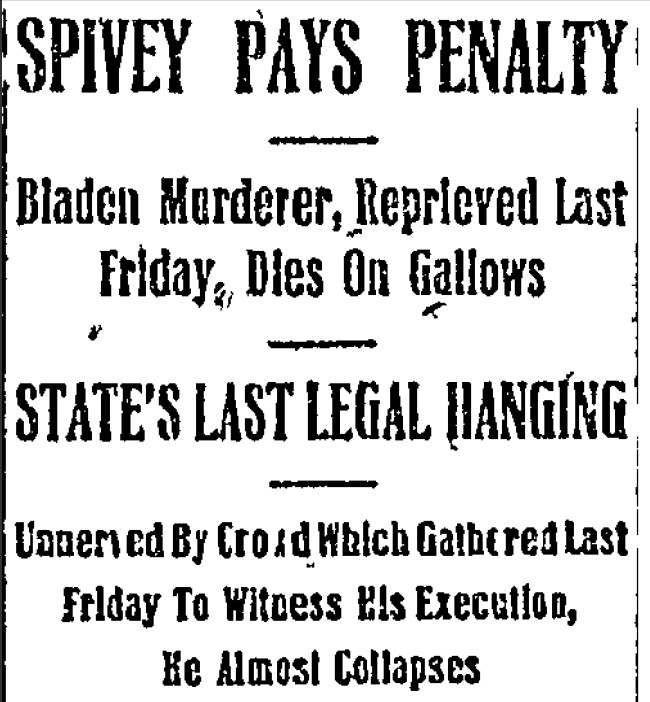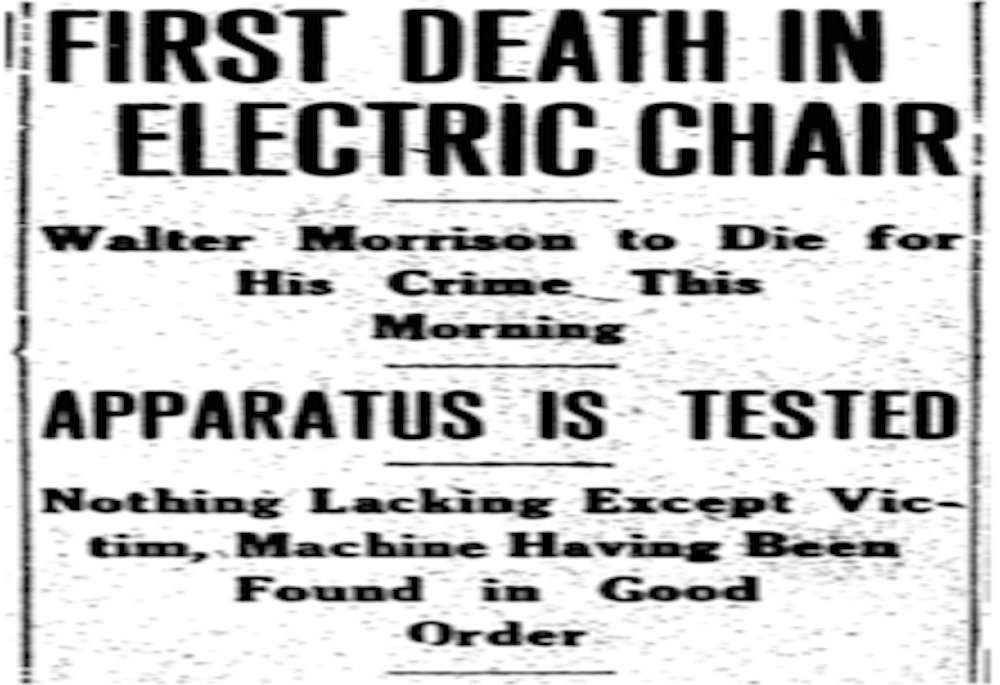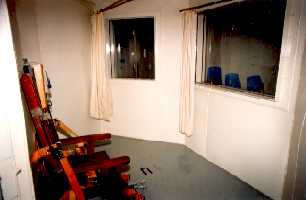Blog
From the Gallows to the Chair

Pentobarbitals, customarily used to euthanize animals in veterinary work, has been utilized in current-day executions. Credit: Jordan Dawe of Creative Columns
In 1910, Henry Spivey was hanged for murder in Bladen County. At this last public stateexecution, The Charlotte Observer reported that as many as a thousand people witnessed thehanging. Spivey was the last person to be hanged in North Carolina; following his death, a newlaw sent the condemned to death row in the electric chair in Raleigh’s Central Prison. With theswitch from public hangings to more private executions, the state broke away from punishmentthat publicly made the tortured criminal an object of “pity or glory.” North Carolina drew a curtain over the process of death and legitimized the state’s power over the execution process.

Newspaper clipping from 1910 noting the final state-sanctioned hanging in North Carolina. Credit: Charlotte Daily Observer, March 12, 1910
The new electric chair at Central Prisonharnessed cutting-edge technology that reflected North Carolinians’ preoccupation with becoming a technologically advanced “civilized” state. Walter Morrison, the first man to beelectrocuted, entered the death chamber on March 18, 1910. He reportedly “plead[ed] piteously for mercy” while clutching a small crucifix. When the switch was pulled, the crucifix fell to his lap.

Credit: Winston Salem Journal, March 18, 1910
North Carolina used the electric chair until 1938, but that did not mean legislators did notcontinue to try to perfect the execution method. In 1936, North Carolina experimented with anew form of lethal punishment when it performed its first gas execution on nineteen-year-oldAllen Foster. The experiment was a failure: The Charlotte Observer characterized the executionas “savage.” Yet the public’s apprehension regarding savagery was short-lived and the methodwas maintained. Between the years of 1983 and 1998, the condemned were obligated to choose between gas and lethal injection. Just two of the ten persons executed between those years chose gas asphyxiation.

between gas and lethal injection. Just two of the ten persons executed between those years chosegas asphyxiation.7 The Central Prison gas chamber used the old electric chair for seating the executed. Courtesy of: North Carolina Department of Safety
The state of North Carolina used a three-drug “cocktail” to execute prisoners via lethalinjection between 1998 and 2006, when a series of complications were introduced into the state’s death penalty protocol that resulted in a de facto moratorium on executions. The two mainissues—physician participation in executions and the applicability of the now repealed RacialJustice Act—continue to hold the death penalty in limbo. But if executions resume, the state willuse a single drug, pentobarbital. Fourteen other states have used pentobarbital for executions, butMedical professionals caution its use in human execution is not well studied. Veterinarians use the drug to euthanize animals.

Pentobarbitals, customarily used to euthanize animals in veterinary work, has been utilized in current-day executions. Credit: Jordan Dawe of Creative Columns
The death penalty has endured through a variety of technological means. Historically,public execution was understood as a quasi-religious event; the actions of the condemned wereevaluated by the crowd for “signs of atonement and the prospect of redemption.” Ironically, thedeath penalty was thought to be a form of rehabilitation, even if it lasted only a few moments before death.
More recently, the prison has been conceptualized as a “‘house of repentance’” in whicha “spiritual transformation” could occur for those unfortunate souls who were not reached by religious institutions outside of the penitentiary. Therefore, the state has assumed spiritualauthority, making religion and forgiveness tools that it can wield to justify total control. Asdeath-row prisoners could not redeem their humanity in the material world, they looked to thespiritual realm as their ultimate option for sympathy.
With each technological advancement, reformers have tried to make capital punishmentreflect progressively more humane views. This dedication to progress has sustained lethalpunishment. The transition from public to private execution and each change gives a veneer ofcivility to North Carolina, a state often thought of as among the South’s most progressive.
Despite these profound changes, the death penalty remains a curious anachronism, living, andkilling, at the intersection of state authority, spiritual power, and public spectacle.
Works Cited:
“Spivey Pays Penalty,” Charlotte Daily Observer, March 12, 1910.
Michel Foucault, Discipline and Punish: The Birth of the Prison (New York: Vintage Books of Random House, 1975), 9.
Trina N. Seitz, “The Killing Chair: North Carolina's Experiment in Civility and the Execution of Allen Foster,” The North Carolina Historical Review 81 (2004): 44.
“History of Capital Punishment in North Carolina,” last modified December 20, 2013.
“State by State Lethal Injection,” last modified November 6, 2015, http://www.deathpenaltyinfo.org/state-lethal-injection.
“Execution Procedure Manual For Single Drug Protocol (Pentobarbital),” last modified 2013, https://www.ncdps.gov/div/AC/Protocol.pdf.
David Garland, “Modes of Capital Punishment: The Death Penalty in Historical Perspective” in America’s Death Penalty Between Past and Present, ed.
David Garland, Randall McGowen, and Michael Meranze. (New York: NYU Press, 2011), 39.
Stuart Banner, The Death Penalty: An American History (Cambridge, MA: Harvard Press, 2002), 102.
Seitz, “The Killing Chair: North Carolina's Experiment in Civility and the Execution of Allen Foster,”44.